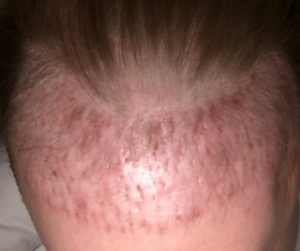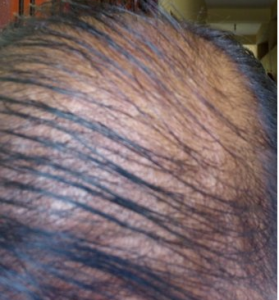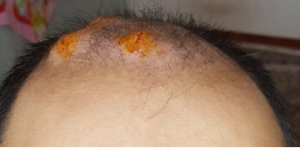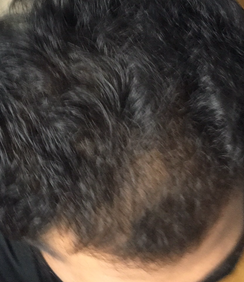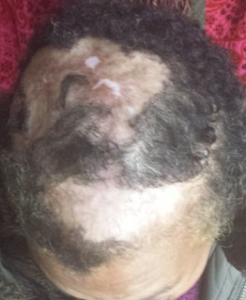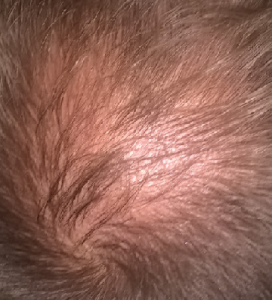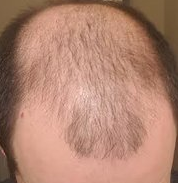50% of men develop genetic balding at some point in their lives. Based upon age, the older you are without any evidence of balding, the less likely you will be in the 50% group of balding men but the genes for balding can start expressing this trait at any age. Rarely, I have seen men start balding at age 50 or greater.
It looks like the recipient wounds were larger than most surgeons use today and the wounds are further spaced out. There is some pitting reflecting some abnormal healing that may get better over time. These surgical techniques may cause increased healing time and they may not completely heal. When the grafts grow in, take a look at what it looks like. You can do another hair transplant with a doctor who does not use such large instruments in the recipient area and can pack in the grafts enough to hide any abnormality that is present.
I have been itching and trying to avoid scratching my head. I use minoxidil and various lotions but without effect. Suggestions??
Minoxidil is an irritant and it can cause problems, but itching can be a sign of healing. I recommend that you never scratch the graft area as it will cause grafts to come out and introduce the possibility of infection. The medications HPR + HydroGel work well for itching and you can get the reference from your doctor or call 1-844-genRx2u to get the medications.
If your hair is fine, the part looks more see-through than when your hair is coarse. It does not mean that something is wrong unless you believe you are losing hair. I always tell people that when I was young, the grown-ups would rub my short hair for luck when they saw me. They did this because my hair was coarse and there was no see-through to the scalp. If I asked you, I’l bet nobody ever did that for you and you agreed, that means that your hair is fine and fine hair never looks very full and the scalp is often seen through the hair.
Both topical and oral finasteride seem to drop the DHT levels. At the 0.25% topical dose, the drop in DHT was less than the oral; nevertheless, reports from some doctors in the field suggest that the sexual side effects still appear with the topical dose
Int J Clin Pharmacol Ther. 2016 Jan;54(1):19-27. doi: 10.5414/CP202467.Effects of a novel finasteride 0.25% topical solution on scalp and serum dihydrotestosterone in healthy men with androgenetic alopecia.
Abstract
OBJECTIVE:
The effects on scalp and serum dihydrotestosterone (DHT) of different doses of a novel topical solution of 0.25% finasteride (P-3074), a type 2 5?-reductase, were investigated in men with androgenetic alopecia.
METHODS:
Two randomized, parallel-group studies were conducted. Study I: 18 men received 1 mL (2.275 mg) P-3074, applied to the scalp once a day (o.d.) or twice a day (b.i.d), or 1 mg oral tablet o.d. for 1 week. Study II: 32 men received P-3074 at the dose of 100 (0.2275 mg), 200 (0.455 mg), 300 (0.6285 mg), or 400 (0.91 mg) ?L or the vehicle o.d. for 1 week. Scalp and serum DHT and serum testosterone were evaluated at baseline and treatment end.
RESULTS:
Change from baseline in scalp DHT was -70% for P-3074 o.d. and approx. -50% for P-3074 b.i.d. and the tablet. Serum DHT decreased by 60 – 70%. The doses of 100 and 200 ?L P-3074 resulted in a -47/-52% scalp DHT reduction, similar to the 300 and 400 ?L doses (i.e., -37/-54%). A -5.6% inhibition was observed for the vehicle. Serum DHT was reduced by only -24/-26% with 100 and 200 ?L P-3074 and by -44/-48% with 300 and 400 ?L P-3074. No relevant changes occurred for serum testosterone.
CONCLUSIONS:
The novel finasteride 0.25% solution applied o.d. at the doses of 100 and 200 ?L results in an appropriate inhibition of scalp DHT potentially minimizing the untoward sexual side-effects linked to a systemic DHT reduction.
Chest pain should always be evaluated by a doctor. Minoxidil, induces low blood pressure and that could bring on Angina, a heart problem that reflects limited blood flow to heart muscles. See a doctor as this drug may have saved your life if I am correct about your heart problem
Setting realistic expectations is critical when undergoing a hair transplant. This is a responsibility of both you and your doctor. Make sure that your doctor did not promise you are full head of hair as the picture shows a very thin look. Go back and speak with him about your pre-operative discussions and the results you have now. I always want my patients to be happy so I rarely promise them the world.
At 18, if you have a hair transplant, you will almost certainly accelerate the loss that you see and get a much larger area. Then you will transplant it again, and more hair loss will follow with then a 3rd transplant and on and on. At your age, the best treatment is the drug finasteride which may very well reverse this without surgery and slow down the development of more hair loss. Doesn’t that make more sense?
This is a complex treatment that involves both balloon expanders and hair transplants. It will take some time to expand the existing scalp and you should look for a surgeon with considerable experience in this type of repair. Everything is not hopeless as I am optimistic that you can make the entire balding area normal again.
I am 21 years old, what does this mean for my future?
This is a sign that you will probably continue to bald in the crown. The drug finasteride, can be applied and maybe reverse this. Try it as you can buy it in the pharmacy, Keep on it for a year at a minimum to get any benefits. IF it does not solve your problem, see a doctor
This is a very important article for our readership, many who use hair dyes and some use hair relaxer agents. “I would be concerned about darker hair dye and hair straighteners,” epidemiologist Tamarra James–Todd said after reviewing the report online now in the journal Carcinogenesis. Tamarra James–Todd is professor, Harvard T.H. Chan School of Public Health, Boston, MA, but was not involved with the new research. “Black women who reported using dark hair dye had a 51% increased risk of breast cancer compared to black women who did not” making this statement very alarming considering the frequency of its use in the African American population”…. “Black women who used chemical straighteners and white women who used dark hair dyes were also at higher risk for breast cancer”…. “Previous studies have shown that long–term users of dark dyes have a 4–fold increased risk of fatal non–Hodgkin’s lymphoma and fatal multiple myeloma, the authors write. Prior research also has associated dark hair dye use with an increased risk of bladder cancer.
Clearly, there are two factors that are critical to determining the value of an FUE graft. (1) the thickness of the hair shaft itself is important as that reflects to weight of each hair shaft as it is viewed. A fine hair is less weight and less value than a coarse hair as shown in the patient’s magnified view of his donor area as he has coarse hair. I tell my patients that two fine hairs is equal to one medium weight hair and two medium weight hairs is equal to one coarse hair. (2) the numbers of hairs per graft is also critical. This is a racial thing, Caucasians average 2.2 hairs in each follicular unit, while all Asians average 1.6 hairs per follicular unit as do many people from the middle east. The patient’s donor area here measures about 1.6 hairs/follicular unit. He is of Arab decent so that makes him average. In this magnified photo, I tried to circle the number of hairs per follicular unit and put a number on many of them. This is what the surgeon sees when he is doing an FUE under magnification. An FUE removes the follicular unit and each FUE itself is created with a punch and has a wound associated with it.
If you ever read about the number of FUE grafts done in Turkey in the 5000 graft/session range, think about it and then look at the patient below. This patient has less hair density than a Caucasian and the number of grafts per FUE will have less hairs. That means that there will be more wounds created for the FUE with a less hair yield. In this man, if he had 5000 FUE grafts in the back of the head and did not develop necrosis of the wound, he would almost certainly develop a see through donor area (balding in the donor area) something that we are now fixing with Scalp Micropigmentation.
To determine if you are a good candidate for hair restoration, you need to know the following and put it all together (1) donor density, (2) degree of balding (you are advanced), (3) the thickness of your hair shafts (fine, medium or coarse, (4) the color of your hair compared to your skin (you have a high contrast between your brown hair and light skin which is not great) and (5) the degree of waviness of your hair (the more wavy, the better. If your donor density is low, the you might not have enough hair to cover the entire balding area and if you should continue to bald further, you may run out of donor hair before finishing. All of the hair in the center of your head is probably miniaturized and will sooner or later fall out. At 35, your hair loss should be slower. With all of this put together, your doctor can build a Master Plan for your hair restoration to account for not only the central hair that will almost certainly be lost, but the sides which may work their way down further than they are now.

